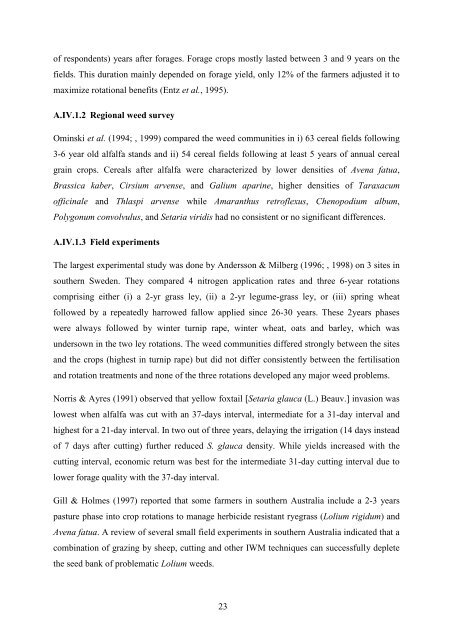Diversifying crop rotations with temporary grasslands - Université de ...
Diversifying crop rotations with temporary grasslands - Université de ...
Diversifying crop rotations with temporary grasslands - Université de ...
Create successful ePaper yourself
Turn your PDF publications into a flip-book with our unique Google optimized e-Paper software.
of respon<strong>de</strong>nts) years after forages. Forage <strong>crop</strong>s mostly lasted between 3 and 9 years on the<br />
fields. This duration mainly <strong>de</strong>pen<strong>de</strong>d on forage yield, only 12% of the farmers adjusted it to<br />
maximize rotational benefits (Entz et al., 1995).<br />
A.IV.1.2 Regional weed survey<br />
Ominski et al. (1994; , 1999) compared the weed communities in i) 63 cereal fields following<br />
3-6 year old alfalfa stands and ii) 54 cereal fields following at least 5 years of annual cereal<br />
grain <strong>crop</strong>s. Cereals after alfalfa were characterized by lower <strong>de</strong>nsities of Avena fatua,<br />
Brassica kaber, Cirsium arvense, and Galium aparine, higher <strong>de</strong>nsities of Taraxacum<br />
officinale and Thlaspi arvense while Amaranthus retroflexus, Chenopodium album,<br />
Polygonum convolvulus, and Setaria viridis had no consistent or no significant differences.<br />
A.IV.1.3 Field experiments<br />
The largest experimental study was done by An<strong>de</strong>rsson & Milberg (1996; , 1998) on 3 sites in<br />
southern Swe<strong>de</strong>n. They compared 4 nitrogen application rates and three 6-year <strong>rotations</strong><br />
comprising either (i) a 2-yr grass ley, (ii) a 2-yr legume-grass ley, or (iii) spring wheat<br />
followed by a repeatedly harrowed fallow applied since 26-30 years. These 2years phases<br />
were always followed by winter turnip rape, winter wheat, oats and barley, which was<br />
un<strong>de</strong>rsown in the two ley <strong>rotations</strong>. The weed communities differed strongly between the sites<br />
and the <strong>crop</strong>s (highest in turnip rape) but did not differ consistently between the fertilisation<br />
and rotation treatments and none of the three <strong>rotations</strong> <strong>de</strong>veloped any major weed problems.<br />
Norris & Ayres (1991) observed that yellow foxtail [Setaria glauca (L.) Beauv.] invasion was<br />
lowest when alfalfa was cut <strong>with</strong> an 37-days interval, intermediate for a 31-day interval and<br />
highest for a 21-day interval. In two out of three years, <strong>de</strong>laying the irrigation (14 days instead<br />
of 7 days after cutting) further reduced S. glauca <strong>de</strong>nsity. While yields increased <strong>with</strong> the<br />
cutting interval, economic return was best for the intermediate 31-day cutting interval due to<br />
lower forage quality <strong>with</strong> the 37-day interval.<br />
Gill & Holmes (1997) reported that some farmers in southern Australia inclu<strong>de</strong> a 2-3 years<br />
pasture phase into <strong>crop</strong> <strong>rotations</strong> to manage herbici<strong>de</strong> resistant ryegrass (Lolium rigidum) and<br />
Avena fatua. A review of several small field experiments in southern Australia indicated that a<br />
combination of grazing by sheep, cutting and other IWM techniques can successfully <strong>de</strong>plete<br />
the seed bank of problematic Lolium weeds.<br />
23

















